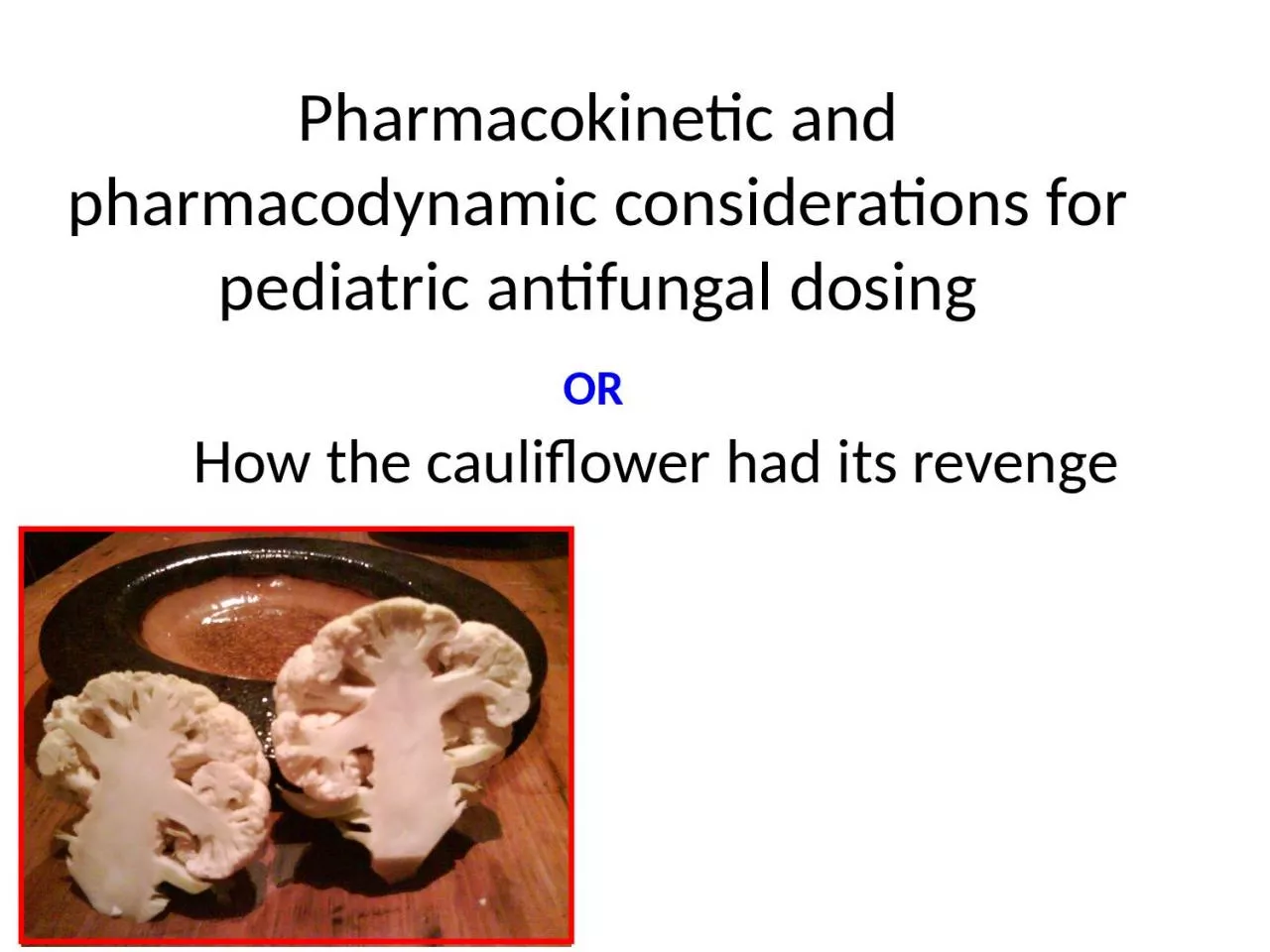

How the cauliflower had its revenge OR Three areas Pharmacometric problem Designing pediatric regimens to produce drug exposure that matches adults Quantifying and managing variability Ideas of control and dosage individualization ID: 936002
Download Presentation The PPT/PDF document "Pharmacokinetic and pharmacodynamic cons..." is the property of its rightful owner. Permission is granted to download and print the materials on this web site for personal, non-commercial use only, and to display it on your personal computer provided you do not modify the materials and that you retain all copyright notices contained in the materials. By downloading content from our website, you accept the terms of this agreement.
Slide1
Pharmacokinetic and pharmacodynamic considerations for pediatric antifungal dosing
How the cauliflower had its revenge
OR
Slide2Three areas
Pharmacometric problemDesigning pediatric regimens to produce drug exposure that matches adultsQuantifying and managing variabilityIdeas of control and dosage individualizationUnderstanding pharmacodynamic differencesPlaced in a drug regulatory framework
Slide3Why are pediatric dosages frequently different to adults?
Is drug exposure in adults and children receiving x mg/kg the same?
Slide4The answer is NO in the majority of cases
But why- especially when we think weight is such a good measure of size?
Slide5Pediatric pharmacology requires an understanding of the biology of size
Slide6Tissues have a supply problem: implications for drug clearance
Hepatic vasculature competes for space with hepatocytesBut, the most efficient transport system takes up a fixed % of volumeSo, if number of cells doubles +
the most efficient transport system is useda more sparsely distributed supply network resultsA more sparsely supplied network is less efficient
Slide7Slide8In summary, therefore
A bigger organ is less efficient per unit sizeA smaller organ is
more efficient per unit sizeFor drug clearance, a bigger liver has more capacity to clear drug, but it is less efficient per unit size
Slide9A myth: children have higher clearances-
they
don’t
n=119
Weight (kg)
Clearance (L/h)
Neonates
Children
Slide10Clearance (L/h)
Weight (kg)
Log-log plot shows a straight line
Slope= 0.75
Neonates
Children
Slide11But, smaller children do have higher weight-corrected clearances
Clearance (L/h/kg)
Weight (kg)
Children
Neonates
Slide12Administering a weight-based dosage results in different drug exposures
Weight (kg)
AUC (mg
·
h/L)
Neonates
Children
Slide13Fact Sheet: Triazoles (see
Lestner et al British J Clin Pharmacology)Fluconazole 6-12 mg/kgVoriconazole 9 mg/kg load + 8 mg/kg q12h
Posaconazole adult regimen down to 8 yrsItraconazole 2.5-5 mg/kg q12h
Slide14Fact Sheet: Polyenes (see Lestner
et al British J Clin Pharmacology)
Slide15Fact Sheet: Echinocandins (see Lestner et al British J
Clin Pharmacology)Caspofungin 70 mg/m2 then 50 mg/m
2 Micafungin 2 mg/kgAnidulafungin 0.75-1.5 mg/kg/day
Slide16Pharmacokinetic Variability
Slide17Variability
Essentially two types of variabilityExplained (covariates like weight, gender, ethnicity, pharmacogenetics etc. etc.)Unexplained (residual)Physicians (in general) generally place too much faith in covariatesChildren have variable PK, most of which we don
’t understand, and cannot predict!!
Slide18Variability is the Issue!
Slide19Consequences of Variability
Lower drug exposure than intendedConcentration-dependent therapeutic failureGeneration of AMRHigher drug exposure than intendedToxicityMakes design of a fixed regimen really quite difficultTrade toxicity and efficacy back and forwards
Slide20What can be done about variability?
Slide21Stochastic Control
Simply means control of system whose properties (state) can only be estimated(i.e. a patient)
Slide22Information from past experiences from many patients is “stored” in population PK models
New Information from a patient now allows a robust estimate of the way a patient is handling a drug
Slide23Slide24Pharmacodynamic differences
Slide25Much of PK-PD bridging makes an assumption that the host is only marginally important
The antifungal drug exerts its effect by docking with the fungus inside the hostThe pathogenesis/ pathology of IFIs is comparable between children and adultsThis argument used by regulators to prevent large clinical studies in childrenBut, there are times when there are pharmacodynamic differences in pediatric patients and adults
Slide26Slide27I’ve told this story many times before, so will not go through the blow-by-blow description
In summary, neonates are at increased risk of hematogenous Candida Meningoencephalitis (HCME)Children and adults don
’t (or rarely) get this diseaseThere are clearly pharmacodynamic differences that require higher weight-based dosages of antifungal agents such as…MicafunginAnidulafungin
Slide28Consequences of giving more drug
Just giving more drug is not necessarily trivial!Issue of tox coverage in preclinical GLP studiesIssue of the safety of the excipientOne issue for anidulafungin is the use of Tween 80, which itself has an upper safety margin
Area of ongoing debate between the EMA and Pfizer about use of anidulafungin in neonates
Slide29Consequences
Debate & tension that revolves around:The preclinical PK-PD model (are they right, are they giving the right answer etc. etc., is the science solid?) PK-PD investigatorsThe risk and cost that is carried by the sponsorThe societal and ethical requirement to develop drugs for children
Regulators
Slide30…and Regulatory Science ≠ Science Science
Over to Brian!